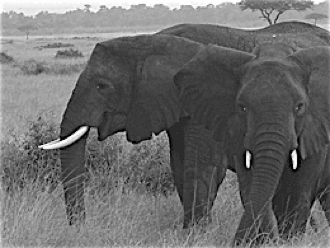What happens if we lose the elephants and other big beasties?

The long-term goal of our research program is to develop general rules8 for predicting the effects of vertebrate extinction on lower trophic levels, especially plants. Ecology is often conducted at restricted spatiotemporal scales, yet society requires answers to questions across landscapes or even continents. As such, extending our mechanistic understanding from experimental studies to the scales of landscapes is one of the principle challenges of modern ecology. Over the next 5-10 years, we expect our research program to shed light on how species interactions, with an explicit focus on vertebrate extinctions, change emergent patterns across ecological systems.
Specifically, we are studying how communities and ecosystems reorganize following the extinction of native, large mammalian herbivores (> 2kg; hereafter “LMH”) in African savannas. Our previous efforts have addressed the functional equivalence of native and introduced herbivores on the establishment of trees in savanna ecosystems9-11. One of our research foci is to understand how LMH affect demographic rates, abundance, and distribution of the genus Acacia, trees that drive nutrient cycling, fire frequency, and biodiversity within savannas12,13, 14, 15. Research to this end focuses on four processes that occur early in the life cycle of Acacia—pollination, seed production, germination, and seedling recruitment to saplings. These four processes comprise a “black box” in our knowledge of the drivers of savanna structure and function12,13.
To return to the research page, click here
1. Diamond, JM. 1984. Pgs 824-862 in Quaternary Extinctions, Martin and Klein.
-
2. Ceballos, G and PR Ehrlich. 2002. Science 296:904-907.
-
3. Brown, JH et al. 2001. Science 293:643-650.
-
4. Walker, BH. 1992. Conserv. Biol. 6:18-23.
-
5. Goheen, JR et al. 2005. Ecology 86:567-573.
-
6. Ernest, SKM et al. 1999. Oikos 88:470-482.
-
7. Agwaral, AA et al. 2007. Front. Ecol. Environ. 5:145-152.
-
8. Knapp, AK et al. 2004. Front. Ecol. Environ. 2:483-491.
-
9. Goheen, JR et al. 2004. Ecology 85:1555-1561.
-
10.Goheen, JR et al. 2007. J. Ecol. 95:129-138.
-
11.Goheen, JR et al. Submitted.
-
12.Scholes, RJ and SR Archer. 1997. Ann. Rev. Ecol. Syst. 28:517-544.
-
13.Midgley, JJ and WJ Bond. 2001. J. Trop. Ecol. 17:871-886.
-
14.Palmer, TM et al. 2008. Science 319:192-195.
-
15.Palmer, TM and AK Brody. 2007. Ecology 88:3004-3011
